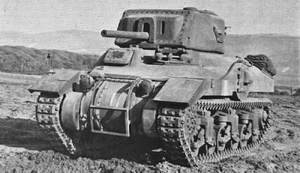Terremoto Medium Tank
This article is incomplete because it is pending further input from participants, or it is a work-in-progress by one author. Please comment on this article's talk page to share your input, comments and questions. Note: To contribute to this article, you may need to seek help from the author(s) of this page. |
| CMT Mark III Terremoto | |
|---|---|
 A Terremoto on trials in Cacerta. | |
| Type | Medium Tank |
| Place of origin | |
| Service history | |
| In service | 1928—1943 |
| Used by | |
| Wars | Siduri War |
| Production history | |
| Designer | Crocetto Heavy Industries |
| Designed | 1930 |
| Manufacturer | Crocetto Heavy Industries Alenia Industrial |
| Produced | 1931—1941 |
| No. built | ~5,382 |
| Specifications (Type 1) | |
| Weight | 29.0 tonnes (31.9 short tons; 28.5 long yons) |
| Length | 5.90 m (19 ft) |
| Width | 3.00 m (9 ft 10 in) |
| Height | 2.67 m (8 ft 9 in) |
| Crew | 5 (commander, gunner, loader, driver, radio operator) |
| Armor | 25—87mm (0.98—3.42 in) |
Main armament | 50mm RA Mark III rifled gun (92 rounds) |
Secondary armament | 2 x Vitali MG50 (12.7mm; coaxial and forward-mounted) |
| Engine | Continental 9-cylinder radial gasoline engine 400 hp (298 kW) |
| Power/weight | 12.3 hp/tonne |
| Transmission | Crocetto clutch, controlled differential |
| Suspension | Vertical volute spring |
Operational range | 232 km (144 mi) |
| Speed | 40 km/h (25 mph) |
The CMT Mark III Terremoto (English: Earthquake) was a Cacertian medium tank developed in the late 1920s and served as the first medium tank deployed by the Cacertian Royal Army designed to combat other armored vehicles. Mounting the 50mm RA Mark III rifled gun, it proved effective against its contemporaries but had a difficult time combating later Common Sphere tanks.
The Mark III was phased out of frontline service by 1936 having been succeeded in its role as tank-fighter by the significantly better-armed Uragano and was relegated to the role of heavy scout tank. It was later replaced in this role by the Zanzara in mid-1937 and officially phased out of service by September of the next year. Many of the Terremotos were scrapped between 1936 and 1938 to provide materials for constructing Uraganos following significant damage to Cacertian supply infrastructure.
Development
The quick adoption of tanks and armored vehicles by other nations throughout Tyran prompted Cacerta’s Ministry of Defense to pursue the design for a Royal Army tank capable of engaging in direct combat with other tanks. The initial specifications were outlined by Demetria Marik and presented to the Royal Army Development Committee in 1930. They drew up plans for a vehicle that possessed a maximum weight of 30,000 kg and mounted a gun that fired armor-piercing shells capable of penetrating most known armor thicknesses of the time period.
Crocetto Heavy Industries and Alenia Industrial both produced prototypes for the project and testing took place in 1927. The Crocetto design was chosen for production and the first model of the designated CMT Mark III was completed in 1931. A leaf-spring suspension was used on most early models built through the 1930s, but all models following were switched over to a bell crank suspension system. The Terremoto was also the first Cacertian tank that featured a three-man turret, allowing the vehicles commander to focus entirely on directing the vehicle and maintaining combat awareness.
Production
The Terremoto entered full-scale production in 1931 and was initially solely produced by Crocetto. Following the introduction of the bell crank suspension and the rising tensions throughout the region, production was expanded to include facilities of Alenia Industrial. The Terremoto was never produced in more than two facilities, as a result monthly production averaged at approximately 40 units per month and never exceeded 100. The introduction of the Uragano in 1936 further slowed production as Cacerta’s industrial capacity shifted to prioritizing the Uragano over the Terremoto.
Design
The CMT Mark III Terremoto was an all-welded medium tank equipped with rolled homogenous armor with a maximum thickness of 50 mm (~2.0 in). It was manned by a crew of five: a tank commander, gunner, loader, driver, and radio operator. The Terremoto had a 240 hp (179 kW) engine with a top speed of 39 km/h on tracks equipped with six rubber-lined road wheels. While the initial 1928 versions did not possess a forward-mounted gun, all models built after 1932 included the secondary armament that was to be operated by the forward-facing radio operator.
The Terremoto sported the 50mm RA Mark III rifled gun as it’s main armament. The cannon fired a 2.7 kg projectile with a muzzle velocity of 850 m/s and was capable of penetrating 105mm of steel armor at 100 m and 70mm penetration at 1,000 m. While the Mark III was a capable anti-tank cannon during the early war, it had a difficult time confronting heavy tanks possessing 100mm angled armor in the later war. Two MG50s HMGs provided anti-infantry armament.
Operational History
Variants
- CMT Mark III Terremoto Type 1
The Type 1 was the primary production variant of the Terremoto and was the most-produced of the Mark III.
- CMT Mark III Terremoto Type 2
The Terremoto Type 2 was an experimental variation of the Mark III the mounted that 75mm RA Mark VI developed for the Uragano. One unit was produced in which the gun proved too heavy for the Terremoto carriage. Following initial testing, the project was later scrapped.